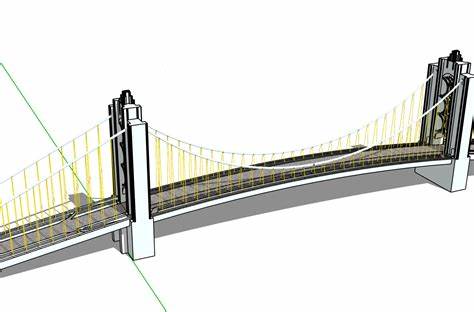Construction Techniques
During the construction process, one of the most challenging aspects is the erection of the main cables. For in – situ spinning methods, wire strands are spun one by one across the span between the towers. Another approach is to pre – fabricate cable segments and then lift and connect them. The construction of the towers also requires precise engineering. Deep foundations are often needed to ensure the stability of the towers under heavy loads.
Advanced surveying and monitoring technologies are employed during construction. GPS systems, strain gauges, and other sensors are used to monitor the position and stress of the structure in real – time. This allows engineers to make timely adjustments and ensure the construction quality.
In terms of materials, high – strength and durable materials are constantly being developed. New types of corrosion – resistant coatings for steel components are used to extend the service life of the bridge.
Future Prospects
Longer Span and Higher Capacity
With the continuous progress of technology, suspension bridges with even longer spans are expected. New materials with higher strength – to – weight ratios may be developed, enabling the construction of bridges that can cross wider bodies of water or valleys. This will further enhance regional connectivity and facilitate transportation and trade. At the same time, the capacity to carry heavier traffic loads will be improved. Designers will optimize the structure to accommodate more lanes of vehicles, high – speed trains, or even combined transportation systems.
Integration of Smart Technologies
The future of suspension bridges will see the extensive integration of smart technologies. Sensors embedded throughout the bridge structure will provide comprehensive data on its health status. These sensors can detect minute changes in stress, temperature, and vibration. Based on this data, predictive maintenance systems can be developed. Bridge management systems will be able to anticipate potential problems and schedule maintenance activities before major failures occur. This will significantly reduce maintenance costs and improve the safety and reliability of the bridges.
Environmental Considerations
In response to growing environmental concerns, future suspension bridge designs will be more environmentally friendly. For example, the use of renewable energy sources to power bridge lighting and other auxiliary systems will be explored. The design of the bridge will also take into account minimizing its impact on the surrounding ecosystem. Efforts will be made to reduce the noise generated during construction and operation and to protect water quality during construction activities. Additionally, the materials used will be more sustainable, with a focus on recyclability and reduced environmental footprint.
Aesthetics and Urban Integration
Suspension bridges will not only be functional but also an important part of the urban and natural landscape. Future designs will pay more attention to aesthetics, creating visually appealing structures that blend harmoniously with the surrounding environment. Bridges may be designed to incorporate public spaces, such as viewing platforms or pedestrian walkways, enhancing the quality of life of local residents and attracting tourists. This integration of function, beauty, and urban context will make suspension bridges more than just transportation infrastructure.
Akashi Kaikyo Bridge (Japan)
-
- It is currently the world’s longest suspension bridge with a main span of 1,991 meters.
- Construction of the Akashi Kaikyo Bridge began in 1988 and was completed in 1998. It connects Kobe on the mainland of Honshu to Awaji Island. The bridge was designed to withstand strong earthquakes and typhoons, which are common in the area. The towers of the bridge are extremely tall, reaching a height of about 283 meters above the water level. The massive main cables, which support the bridge deck, are made of high – strength steel wires.
- Xihoumen Bridge (China)
- With a main span of 1,650 meters, it is one of the largest suspension bridges in the world.
- The Xihoumen Bridge is located in the Zhoushan Archipelago in China and was completed in 2009. It plays a crucial role in improving transportation connections in the region and promoting economic development. The bridge’s design takes into account the harsh marine environment, including strong winds, waves, and corrosive seawater. The construction process involved advanced engineering techniques for the erection of the main cables and the installation of the bridge deck.
- Great Belt Bridge (Denmark)
- The main span of the East Bridge of the Great Belt Bridge is 1,624 meters.
- Completed in 1998, it connects the islands of Zealand and Funen in Denmark. The bridge is an important part of the European highway network and has had a significant impact on transportation and trade in the region. The design of the bridge had to consider factors such as the heavy traffic loads it would carry and the environmental conditions of the Baltic Sea area.
Post time: Nov-15-2024


